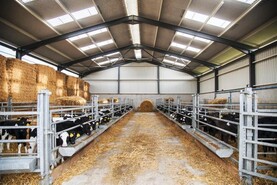New research has revealed that young farmers and farmers with smaller holdings are more likely to breach national nitrates rules. Authors of the report said the information was surprising and counter to what was previously believed, with older farmers traditionally thought to be less adaptable to rules. Farmers under 40 were “significantly” more likely to breach regulations.
Ireland’s water quality and the impact of farming practices is coming under increasing scrutiny and the study implied that “more intensive” measures would be put forward to replace the warning letter currently in use by the Department.
Some fingers have pointed to dairy expansion post-quotas as being the reason for breaching stocking rate limits. A high number of farmers that had been compliant in 2014 breached nitrate limits in 2015.
The nitrates directive applies to all farms and means that farmers can’t exceed 170kg of organic nitrogen per hectare, except where they obtain a derogation. This is the equivalent of two dairy cows per hectare. Farmers who have a nitrates derogation can increase the stocking rate to 250kg of organic nitrogen per hectare but the study focused on the general limit. Approximately 11,000 letters are sent to farmers every year by the Department of Agriculture, warning them they have reached 150kg mark and are at risk of breaching the 170kg limit and incurring a financial penalty.
Waterford farmers and farmer in the southeast of the country were found to be the worst offenders in terms of nitrates breaches.
The Economic and Social Research Institute (ESRI) study, Predicting farms’ non-compliance with regulations on nitrate pollution, looked at ways to determine characteristics of repeat or likely offenders to better target early intervention.
Comment
This paper is a modelling exercise to look at the “odds” of a category of farmers breaking a stocking rate limit. We know about 1.5% (2,000 of 140,000) of farmers each year exceed allowed stocking rates and these are classed as violations for this study. In simple terms, a violation could be an issue such as stocking the farm at 175kg organic nitrogen (2.05 cows/ha) when you should be under 170kg (two cows/ha).
Most farmers will adjust stocking rates depending on the season, grass growth and livestock prices. Hence, the farm could have a marginally higher stocking rate for a certain period of time which, in theory, could push them slightly over allowed stocking rate limits.
Read more
Major changes in the pipeline for nitrates legislation
Farm Buildings: a tidy handling unit for 40 cattle
New research has revealed that young farmers and farmers with smaller holdings are more likely to breach national nitrates rules. Authors of the report said the information was surprising and counter to what was previously believed, with older farmers traditionally thought to be less adaptable to rules. Farmers under 40 were “significantly” more likely to breach regulations.
Ireland’s water quality and the impact of farming practices is coming under increasing scrutiny and the study implied that “more intensive” measures would be put forward to replace the warning letter currently in use by the Department.
Some fingers have pointed to dairy expansion post-quotas as being the reason for breaching stocking rate limits. A high number of farmers that had been compliant in 2014 breached nitrate limits in 2015.
The nitrates directive applies to all farms and means that farmers can’t exceed 170kg of organic nitrogen per hectare, except where they obtain a derogation. This is the equivalent of two dairy cows per hectare. Farmers who have a nitrates derogation can increase the stocking rate to 250kg of organic nitrogen per hectare but the study focused on the general limit. Approximately 11,000 letters are sent to farmers every year by the Department of Agriculture, warning them they have reached 150kg mark and are at risk of breaching the 170kg limit and incurring a financial penalty.
Waterford farmers and farmer in the southeast of the country were found to be the worst offenders in terms of nitrates breaches.
The Economic and Social Research Institute (ESRI) study, Predicting farms’ non-compliance with regulations on nitrate pollution, looked at ways to determine characteristics of repeat or likely offenders to better target early intervention.
Comment
This paper is a modelling exercise to look at the “odds” of a category of farmers breaking a stocking rate limit. We know about 1.5% (2,000 of 140,000) of farmers each year exceed allowed stocking rates and these are classed as violations for this study. In simple terms, a violation could be an issue such as stocking the farm at 175kg organic nitrogen (2.05 cows/ha) when you should be under 170kg (two cows/ha).
Most farmers will adjust stocking rates depending on the season, grass growth and livestock prices. Hence, the farm could have a marginally higher stocking rate for a certain period of time which, in theory, could push them slightly over allowed stocking rate limits.
Read more
Major changes in the pipeline for nitrates legislation
Farm Buildings: a tidy handling unit for 40 cattle






 This is a subscriber-only article
This is a subscriber-only article










SHARING OPTIONS: